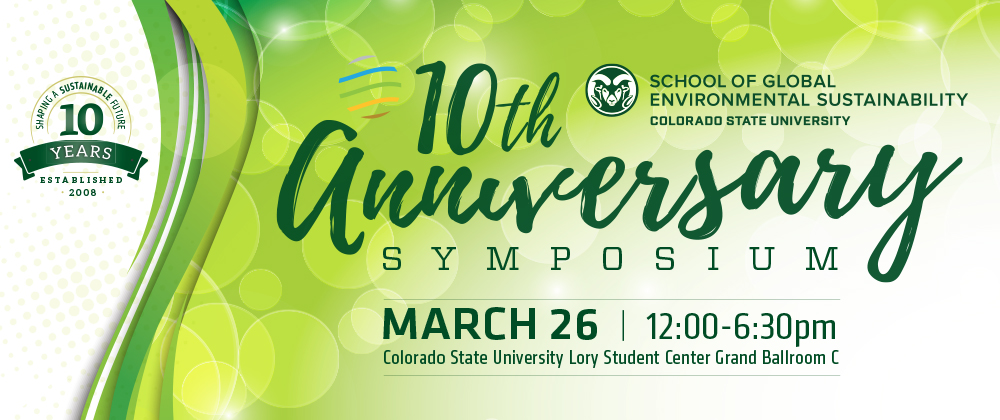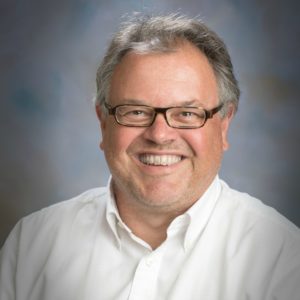
As a culmination of festivities marking its 10-year anniversary, the School of Global Environmental Sustainability at Colorado State University will host a symposium offering a variety of perspectives on sustainability. Peter Backlund, associate director of SoGES, talks about the lineup for the event, the team’s highlights in recent years, and what’s to come.
Looking back at the last five years, what would you say are the accomplishments you’re most proud of at the School of Global Environmental Sustainability?
One thing that has been really interesting over the last three years or so is the growth in enrollment in our minor. It shows student interest in the topic and student interest in our school. It also is an indicator that SoGES has been successful in building a community around global issues in sustainability and the societal engagement of students. Young people now have a strong commitment to wanting to make a difference in the world. Sustainability is part of that.
Register, learn more about the symposium
The 10th anniversary symposium kicks off at noon and will run until 6:30 p.m., including a reception, in Grand Ballroom C in the Lory Student Center.
See the detailed agenda online: https://col.st/2cax2
Admission is free but registration is required: https://col.st/ZpfuL
Related to that, we’ve seen an increase in the number of people who have signed up to become affiliate faculty members in SoGES. That’s quite encouraging. We’re up to over 125 affiliate faculty, and these roles are strictly volunteer. We hope to benefit from their expertise and have them be a part of our community.
The third thing is that we have an annual competition where we award small exploratory grants to develop new research ideas, and we consistently have strong interest in this program. We get a lot of very creative proposals and we could fund twice as many as we do if we had the resources. It’s not that unusual to see biologists collaborate with ecologists or biologists collaborate with engineers. But when we see an art professor, English professor, ecologist and an engineer submit an idea for a research project, that’s pretty cool.
That’s a sign of people coming together to address issues in a new way. It also shows environmental sustainability is a societal issue: How do we think about the world, how do we frame questions, how do we talk about sustainability and communicate about it?
How important is it for CSU to have SoGES, given increasing awareness about climate change, and the need for sustainable environmental solutions and approach?
Climate change is probably the most publicized sustainability issue. It’s at the forefront of people’s consciousness now, and it’s important for universities to respond to that.
Sustainability science is not just about explaining it’s an issue, but also trying to find solutions.
I’ve been very encouraged by a number of young researchers at CSU working in sustainability science. One of the things that attracts them to this endeavor is because it’s about trying to make the world a better place. It’s trying to apply research and science and knowledge to improving the world. That’s very attractive for students. That’s important for universities to offer. It’s also a great match with the land-grant ethos that President Tony Frank is so eloquent about.
What are you, personally, most of proud of, in your role at SoGES?
On a personal level, I’m most proud of helping to pull all of this together. SoGES has given me a home where I have the ability and freedom to pursue my own work that dovetails with what we do.

There are ups and downs, like in any organization, but I’m proud of the fact that I’ve contributed to solidifying our team. I don’t want to overstate my role with that. It all started with SoGES Director Diana Wall. She deserves a tremendous amount of credit for having the vision. It’s like what Thomas Edison said: Genius is 1 percent inspiration, and 99 percent perspiration. Diana was willing to put the perspiration in, to go from that idea to what we have today, it’s amazing. I’m proud to add to that.
What should people expect from SoGES in the next five to 10 years?
People should expect to see us expand our educational offerings. We’re looking to expand not just the number of courses, but also exploring degree options. We are working hard on developing an undergraduate major. It still has to go through many levels of approval before it’s a done deal, but we’ve got a lot of momentum in that direction. We are putting a lot of work into planning a major that builds on the interdisciplinary approach with our minor.
We work with early career researchers, particularly around science communications, through the Sustainability Leadership Fellows program, and we’ve had so much success with that. We are looking at ways to build on and extend that model. The current model is targeted at Ph.D. candidates and post-docs. We are thinking about options to expand that perhaps to master’s level students and a different set of graduate students, and perhaps opportunities to extend it to faculty.
SoGES is looking at similar programs at other universities, to see how we might build linkages and share our knowledge. We are working with others to expand the program to be national and international, in part through our role in Future Earth or perhaps through a consortium of universities.
We would like to do more in research as well. In recent years, we are bringing in significant outside support. We’ve won more grants to support our efforts and we’d like to bring in more grants and other external research funding.
We are starting to see the value in trying to promote more engagement of the sustainability research community at CSU with the outside world. Researchers are interacting with the city of Fort Collins more, as one example. We’re very interested in facilitating more of that. Diana and I both, in our own work, are working hard at promoting and solidifying the link with the science community writ large, bringing that to the attention of national and international organizations. We would like to promote and enable these deeper connections as part of the notion of sustainability making the world a better place.
What should people expect from the upcoming symposium?
People can expect an afternoon of exciting talks and discussions. We have a couple of great plenary and keynote speakers. One of them is Pam Matson, who was most recently the dean of the Stanford University School of Earth, Energy & Environmental Sciences, and remains a professor at Stanford. She’s been one of the eminent leaders in sustainability science for a long time, and is a former member of our external advisory council.
The other big talk is from Sir Robert Watson, a British chemist who is perhaps the global leader in devising and implementing scientific assessments. He is the chair of the Intergovernmental Panel on Biodiversity Ecosystem Services and served as chair of the Intergovernmental Panel on Climate Change. He was my boss at the White House in the Office of Science and Technology Policy, and he’s been an advisor to organizations including the World Bank. He’s one of the most influential scientists in the world.
We also have three panels, including one with early career researchers, who will talk about the future of sustainability. We will have a group of scientists and economists talking about the Green New Deal and we have a panel on sustainability leadership to close this all out.
So, we will have everyone from graduate students to the president of the university talking about their perspectives on sustainability.
We will also have something that’s a little different. One of the creative teams we funded brought together scientists, creative writers, and poets. They’ve developed a performance art piece that uses deletion; they delete text from iconic works of literature as a metaphor for deleting species. They will perform that piece – scientists working with poets around the loss of biodiversity. I could not be more excited about this even though it’s only one part of the symposium.
Prior to joining SoGES, Backlund was a member of the leadership team of the National Center for Atmospheric Research, where he led strategic planning, oversaw relationships with sponsors and other research organizations, and developed a series of interdisciplinary projects that combined atmospheric, social, health, ecological, and hydrological science. He also previously served as a senior advisor in the White House Office of Science and Technology Policy, where he focused on climate change science, assessment and policy, evaluation, planning, and coordination of environmental science programs and budgets and communication of environmental science and technology issues to senior officials, industry, the academic community, the public, and the Congress. Backlund is a fellow of the American Association for the Advancement of Science.